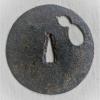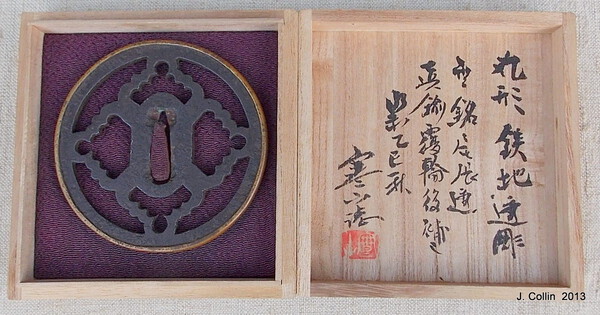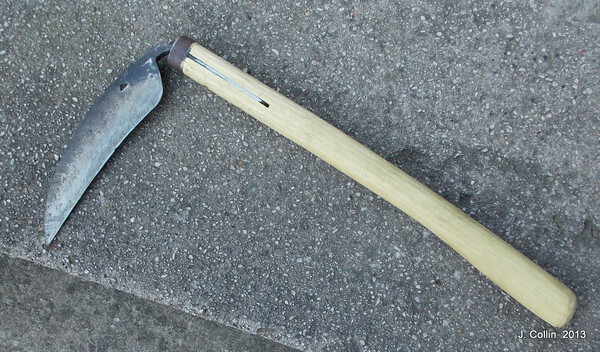-
Posts
6,161 -
Joined
-
Last visited
-
Days Won
20
Content Type
Profiles
Forums
Events
Store
Downloads
Gallery
Everything posted by ROKUJURO
-
Dear Sirs Thank you a lot for your comments. I did not intend to send the above mentioned TSUBA (w 84 x h 85 x t 4,5 mm) to a SHINSA panel. But AOI/TSURUTA-SAN often sell TSUBA with a paper, and I was just wondering why a TSUBA with KANZAN HAKOGAKI did not have one. So my suspicion was that TSUBA and box might not belong together, as Mariusz suspects. It is indeed a later TSUBA, but besides all, I like the design which is probably not representing a floral motif, as Henry underlines. It was not sold as OWARI, so I had an idea why it was not expensive.
-
Good evening! I had the opportunity to purchase a few TSUBA, and there are some questions coming up: The first TSUBA is an OWARI, and it has a HAKOGAKI by Dr. KANZAN, but no papers. My question is if a TSUBA that has been altered, e.g. by a copper FUKURIN, will be refused by the SHINSA commission and not be papered? Would it get papers without that additional rim? Of course I would appreciate a translation of the HAKOGAKI if someone would be so kind! Thank you in advance for your efforts!
-
Mark, difficult to say from the photos, but as you say, the upper TSUBA looks a bit rough and not really carved with chisels and tools. For a better evaluation, you have to have it in hand. The large depressions are not necessarily hammered as in TEMPO TSUBA; they could have been carved as well. And the 'grey metal' might well be cast iron. If so, the TSUBA is not very old. But as said above, the black paint (not necessarily lacquer) prevents a better judgement. For me, the little TSUBA is not easy to relate to a school. I would look for one like KINAI who have a tradition of MARU BORI. The age might very roughly be mid EDO, but age is never an aspect of value or quality.
-
Mark, is the first TSUBA magnetic? On the photo I have an impression it could be a black painted copy of a TSUBA, made from a zinc alloy. But that may well be an effect of the picture. The little 'moon hare' TSUBA looks like iron and will profit from a careful restoration with a pointed bamboo, bone, or ivory tool.
-
Jesse, the photos are out of focus. Try again please!
-
Ken, I can read BIZEN KUNI no JU KAGEMITSU
-
Might have been used as handle of a walking stick or an umbrella.
-
Jason, that would look fancy but not like a traditional Japanese TSUBA. The meteorite can be forged, but it will loose the Widmannstätten pattern. If you want to keep that, you just have to find a meteorite with the necessary dimensions, cut off a thin slice and shape it like a TSUBA. Would nicely combine with a neon green SAYA, I am afraid..... The same applies to a KATANA with meteorite steel: no pattern after forging.
-
I don't see a reason why a Chinese person should not be able to write nice KANJI, but in this case I have a feeling that these were written by a person not trained in using a chisel.
-

The Question On All Our Minds
ROKUJURO replied to Shamsy's topic in Auctions and Online Sales or Sellers
Shamsy, these are war time swords and have nothing to do with NIHONTO. They were factory made in thousands and there is no craftsmanship involved. There are hand-forged blades in existence which were made in traditional ways. -

Japanese Polish On Foreign Swords?
ROKUJURO replied to Peter Bleed's topic in General Nihonto Related Discussion
Peter, there is a certain Dr. Stefan Mäder, who used to live in Japan for quite a while. He is known as a researcher in the field of early medieval sword blades and at one time, had Alamannic blades polished in Japan. Amazing enough, these blades had a kind of HAMON! One of his treatises can be found under: http://www.archaeologie-online.de/magazin/thema/die-alamannen/mado-wo-akeru-ein-fenster-oeffnen/seite-1/ Hope that helps! -
As far as I know KO-KATCHUSHI TSUBA are mostly quite thin and can be large. The DOTE MIMI might be a hint for a KATCHUSHI design, but in this case the plate seems relatively recent and not as old as KAMAKURA JIDAI where the beginning of KO-KATCHUSHI TSUBA manufacture is located.
-
Looks like a Japanese blade in a south east Asian KOSHIRAE (Myanmar, Thailand or so)
-
Actually, the use of meteoric iron in the manufacture of blades is not very rare. It has been used by the Malayan EMPU, the smiths of the famous kriss, for a long time, and some bladesmiths still use it today in very special knife-blades. Generally, meteoric iron is low in carbon but rich in nickel content, which allows a combination with another steel with high carbon, high manganese content to receive a Damascus steel with good contrast. So it is very likely that a KATANA blade with satisfying technical properties will contain only a small portion of meteoric iron, merely for a publicity effect.
-
Hoan, could this be http://en.wiktionary.org/wiki/%E8%A5%BF? Looks similar!
-
Grev, perhaps it is KATO TERUAKI of the ISHIGURO school (AIZU SHOAMI)?
-
Louis, I have seen a few like this. To me it looks as if heavy corrosion had been removed in an amateurish way to stop the rust. The results are not beautiful.....
-

Red Rust On Nakago - How To Treat (Covering Mei)
ROKUJURO replied to CurtisR's topic in General Nihonto Related Discussion
Curtis, this does not look really bad to my eyes! I would not even call this 'covered with red rust', although there is some of it. The NAKAGO is intact, and a soft brush might already do the job. I even used a brass brush without doing any harm, although I had to wipe off some brass 'colouring' from the NAKAGO with oil and a rag. Of course you might proceed more sensitively with a KAMAKURA period blade.... -
Hearthammer, please sign your posts with at least your first name to be politely addressed. Wherever the blade was found or what story you were told, it is very probably not Japanese as far as a photo allows a comment. MUNEMACHI/ HAMACHI are not in the traditional positions, the NAKAGO is so crudely made that it does not at all seem Japanese, as was said before. A comparison with original Japanese blades would show you what a blade should look like. If better photos should provide evidence for YAKIBA/HAMON or HADA, then another judgement (falsely shortened blade?) might arise. By the way, the TSUKA ITO (handle binding) is not Japanese.
- 13 replies
-
- wakizashi
- translation
-
(and 1 more)
Tagged with:
-
Axel, I would really like to have Ford's comment on this TSUBA. To me it looks like a new CNC copy of an otherwise nice design. I may be completetly wrong, but the lines of the SUKASHI are not as smoothly cut and filed as I would expect from a traditionally made TSUBA. To my eye, it looks as if some drilled holes have been used to form waves, but maybe it is my lack of experience to judge this way.
-
Steven, to my old eyes the animal looks more like an ox instead of a boar. Have a close look!
-
Correct, but that applies also to your post!
-

Kama, Jingama, Kusari-gama, Kama-yari etc.
ROKUJURO replied to Bugyotsuji's topic in General Nihonto Related Discussion
I can only offer a picture of a standard KAMA which I made a while ago and which I use in the garden. It serves very well the purpose. -
Grev, I cannot add any idea to the design of this TSUBA, but the TAGANE around the NAKAGO-ANA show a strange form. The metal seems to have broken and did not react as usual. Are you sure it is not cast?
-
Jason, if you turn the photo 90° to the right you may probably see a NATA, a Japanese hatchet. It is frequently seen, I even have a TSUBA with a NATA for sale.





